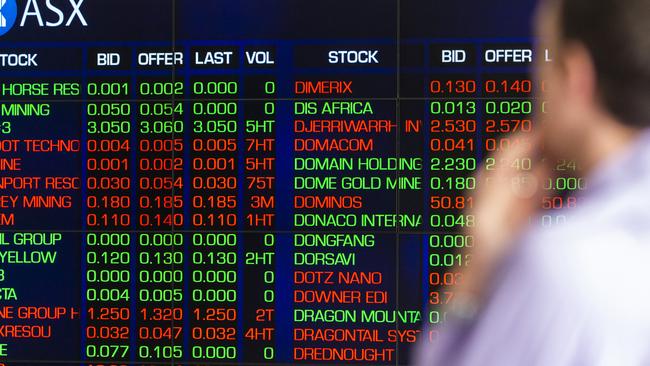US bets on a fiscal deal to stimulate economy
Australia’s sharemarket took a breather after Friday’s surge in banks, but the US market appeared to be betting on a last-minute fiscal agreement before the US election, however unlikely it seemed.

Australia’s sharemarket took a breather after Friday’s surge in banks, but the US market appeared to be betting on a last-minute fiscal agreement before the US election, however unlikely it seemed.
While the S&P/ASX 200 Index slipped 0.2 per cent to 5952.3 points as the heavyweight banks and miners fell back, encouraging coronavirus and reopening trends domestically saw big gains in travel and real estate stocks.
Interestingly, the Dow Jones Industrial Average looked set to lead another jump on Wall Street despite a potentially damaging New York Times report on President Trump’s indebtedness, foreign income and minimal tax payments in recent decades, which Trump dismissed as “fake news”.
While perhaps not a game changer, it certainly didn’t help Trump’s re-election chances.
The spread between the average of betting odds widened to the biggest gap in favour of Democratic Party candidate Joe Biden in almost five weeks. Thus Monday’s strong gains in US stock index futures during Asian trading hours — including a 1 per cent rise in DJIA futures — showed the extent to which the market was once again betting on a fiscal deal that would help the economy, even with all the acrimony between US lawmakers over Amy Coney Barrett’s Supreme Court nomination by Trump.
After the close on Friday, Bloomberg reported that House Speaker Nancy Pelosi and Treasury Secretary Steven Mnuchin resumed talks on a stalled fiscal stimulus package, although there was no indication it provided any breakthroughs. US economists see little chance of a deal.
After Goldman Sachs and JPMorgan economists slashed their December quarter US economic growth forecasts, Morgan Stanley did the same on Monday.
Morgan Stanley’s Ellen Zentner forecast annualised US December-quarter GDP growth of 3.5 per cent, down from her period forecast of 9.3 per cent. And she lowered her year-on-year forecast to -2.7 per cent from a previous forecast of -1.5 per cent, as a “Cares 2” stimulus package was “unlikely to be delivered this year”.
“Fiscal restraint will test the resilience of the economic recovery, but we continue to believe that there has been enough progress in the recovery and that there is enough momentum in underlying economic activity to keep the US economy on pace to return to pre-COVID-19 levels of real GDP by the middle of next year,” she says. And Morgan Stanley’s top-rated US equity strategist, Michael Wilson, says that with the combination of the US “fiscal cliff”, the prospect of a second-wave of coronavirus and new lockdowns in the US, bottoming real interest rates, plus the looming election and associated uncertainty about its validity and the timing of a definitive result, “uncertainty has rarely been higher for financial markets”.
Yet while options markets are pricing in higher risk than normal around the US election, he says it’s nothing like we experienced in 2016, which doesn’t seem right, given the uncertainty about the election process and results that is building.
“As a result, I expect volatility to remain high for the next four to five weeks, creating what is likely to be a difficult trading environment,” Wilson says.
“Despite this seemingly consensus view, both gross and net exposures for our institutional clients remain decidedly elevated. When volatility and beta are adjusted, they stand at all-time highs.” In his view, that means that high volatility and “fairly trendless” markets will see these institutions lower their US equities exposures over the next few weeks. “That means lower equity prices before this correction is over,” he says.
Wilson is targeting 200-day moving averages for the S&P 500 and Nasdaq 100 about 6 per cent and 14 per cent lower, respectively, as “good levels to think about”.
“Looking beyond the near term, I think three of these risks are likely to be resolved positively by the end of the year or shortly thereafter,” Wilson adds.
“Meaning, more fiscal stimulus is likely as both parties want to spend more but may not be able to come to terms before the election. More market pressure will likely help to get it done sooner.
“Meanwhile, progress on a vaccine and natural herd immunity via a second wave should become clearer, and we will have a conclusion to the election.”
At the same time, Australian equities have been raised to “overweight” in Morgan Stanley’s regional model.
“Virus and policy evolution start to offer a clearer recovery path whilst aggregate earnings are troughing,” says the US Investment bank’s head of Australian research, Chris Nicol.
“The ASX 200 could again play a dependable and defensive role in the context of a more volatile regional backdrop.”
He noted that despite a better-than-feared initial COVID-19 impact and best-in-class economic trough, the ASX200 lagged developed markets peers when comparing recovery in equity market levels from their crisis lows, but “catch-up catalysts” are now in focus from investors.
“The set-up from here is interesting where Australia’s recovery outlook contrasts with developed market economies entering winter and second-wave COVID-19 risks rising amid fiscal debates and varying recovery impacts,” Nicol says.
“In comparison, Australia … is already emerging from its own second wave in Victoria, has established a longer duration for crisis support, plans to recalibrate the fiscal pulse and pursue outsized traditional growth stimulus, and aims to confront seasonal virus scenarios next winter at a time when base case vaccine availability is expected to be in play.
“This allows Australia to once again offer defensive growth appeal in a regional setting.”







To join the conversation, please log in. Don't have an account? Register
Join the conversation, you are commenting as Logout